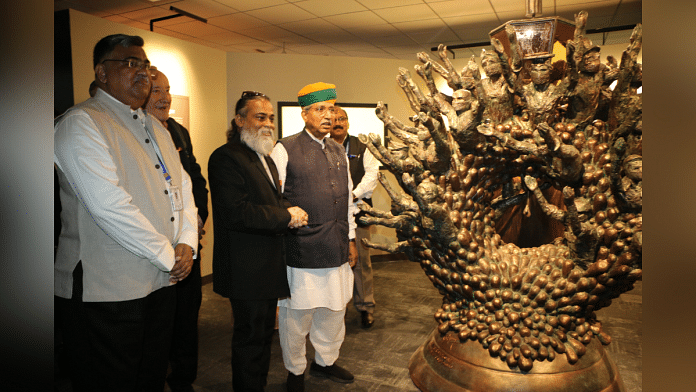New Delhi: Art, scientific achievement and emphatic storytelling — the confluence of these three manifested itself in a new exhibition, ‘Vaccines: Injecting Hope’ which was inaugurated at the National Science Centre in Delhi on 15 November.
A look into what two years of the pandemic meant for the scientific world, this educational exhibit displays the work, vigour and immense effort that went into creating a vaccine against Covid, and how India and the UK addressed one of the greatest collective challenges.
“Knowing the Science is not enough, Science has to reach people through Art,” said Rajiv Bahl, Director General of the Indian Council of Medical Research (ICMR) at the inauguration.
The exhibition also showcases an art installation, which was commissioned by the British Council as part of the ‘India/UK Together Season of Culture’. The artwork and the exhibition drew inspiration from a 19th Century painting titled, ‘3 Princesses of Mysore’, by Thomas Hickey which was used to promote smallpox vaccination through royalty.
“This early example of public messaging through art, where one princess draws your attention to her arm, connects us from the past to the future,” said Scott McDonald, Chief Executive British Council.
“All of us need a healthy dose of hope to inoculate ourselves during tough times,” he added during his inaugural address.
While many officials of the National Council of Science Museum of India, representatives of the British Council, and those from the Science Museum Group were present at the inaugural event — Arjun Ram Meghwal, Minister of State for Culture and Parliamentary Affairs and the joint secretary of Ministry of Culture Mugdha Sinha represented the government. The Maharaja of Mysore was also present at the event.
Seeing a collaboration between the National Council of Science Museums and Science Museum Group, London, this transnational effort tells the story of global endeavor and everything that went on behind the scenes to develop vaccines at pandemic speed.
All that went down behind the scenes
The sections across the exhibition take the viewer through the whole experience and work that went into giving India its vaccine which has immunised 93% of the population with two shots. From the various equipment used in the creation of the vaccine such as bioreactors, to the suits worth Rs 16 lakh and worn by various scientists when dealing with the virus, the gallery is rich with nostalgia for those who worked day and night to prepare the vaccine for India’s citizens.
Even the actual container in which the first sample of Covid was brought from Kerala for testing, is present in the gallery, alongside different vials which were used to test and store the Omicron variant of SARS-CoV-2. The mask which was worn by healthline workers during the bubonic plagues of yore also sits next to the present day mask worn by people everyday.
Pragya Yadav, an award-winning Indian scientist at the ICMR-National Institute of Virology (NIV), who led the team that handled SARS-CoV-2, told ThePrint, “The vaccine was a hope and a tool that not only saved lives but engaged people in biological science. This simplistic illustration will really help children and students understand the journey of India’s vaccine.”
“I do still advise one to wash their hands and wear masks in large crowds,” she added to ensure that citizens still practiced caution.
It started during the pandemic
“Vaccines are something that were not on top of people’s minds or gained a lot of investment before the pandemic hit us. And earlier there were these people working quietly, after which there came a sudden panic as people started demanding vaccines. Not only were all these scientists rediscovered, but they also did it in record time,” Sir Ian Blatchford, Director and Chief Executive Science Museum Group, told ThePrint.
As he recalled the panic and chaos of the first lockdown in 2020 and the people who died, he calls this achievement a “miracle”, now documented in the exhibition that has been in the works for months.
Science and art come together
The exhibition features, ‘Through the lens’, an artwork commissioned by British Council in collaboration with Delhi-based sculptor Sushank Kumar and British playwright Nigel Townsend.
Jonathan Kennedy, the Director Arts for the British Council in India, told ThePrint, “We wanted to think about the global challenge of the pandemic and how institutions worked together between India and the UK to create and distribute the vaccine, from the perspective of artists. We wanted to dive into the human story that could be told, through them.”
A Mobile Science Exhibition, another version of the exhibit, is set to travel to rural areas across northern India. In the meanwhile, the primary exhibition will be open in Delhi till June 2023, after which it will travel to Nagpur, Mumbai, Bangalore and Kolkata.
Also read: First mega-science show begins in Mumbai, on agenda Big Bang theory & evolution of stars



